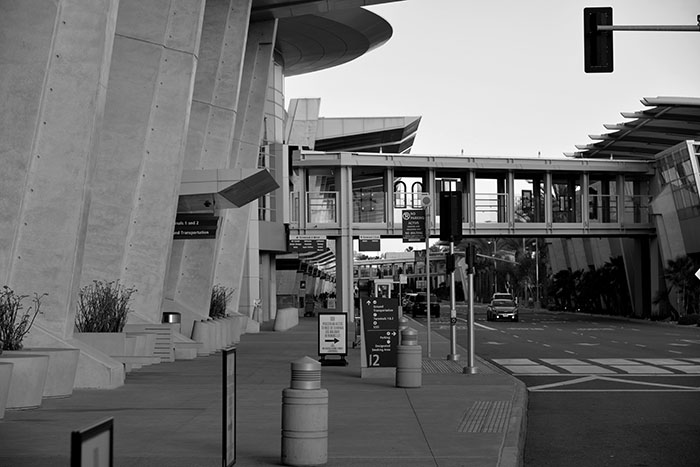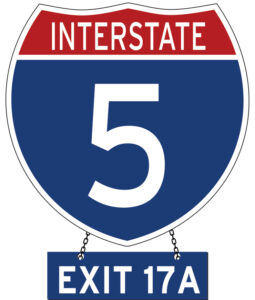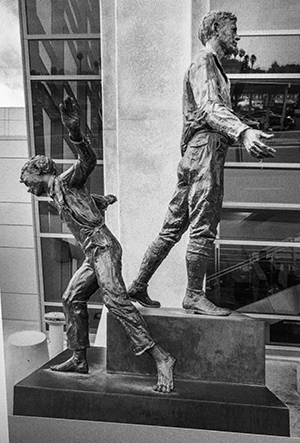
Chapter 27, Exit 17A (Hawthorn Street): San Diego International Airport
Make a left turn from the Hawthorn Street exit and follow it all the way down to Harbor Drive. Make a right and the airport will be ahead at 3225 N. Harbor Drive.

 There was a time the San Diego International Airport was known by everyone as Lindbergh Field after the aviator Charles Lindbergh, who spent a lot of time in town overseeing the construction of his airplane, “The Spirit of St. Louis,” by Ryan Aircraft. After the job was completed, Lindbergh made several stops across country en route to New York, including in St. Louis. This was where donors lived who had financed his plane. Then, on May 21, 1927, Lindbergh, the 25-year-old pilot, completed the first solo flight across the Atlantic Ocean, in the process becoming an international celebrity. If he had simply retired on his laurels at that point in his life, the name “Lindbergh Field” today might still be emblazoned across the airport entrance.
There was a time the San Diego International Airport was known by everyone as Lindbergh Field after the aviator Charles Lindbergh, who spent a lot of time in town overseeing the construction of his airplane, “The Spirit of St. Louis,” by Ryan Aircraft. After the job was completed, Lindbergh made several stops across country en route to New York, including in St. Louis. This was where donors lived who had financed his plane. Then, on May 21, 1927, Lindbergh, the 25-year-old pilot, completed the first solo flight across the Atlantic Ocean, in the process becoming an international celebrity. If he had simply retired on his laurels at that point in his life, the name “Lindbergh Field” today might still be emblazoned across the airport entrance.
However, Lindbergh became enamored with “eugenics,” the pseudo-science that posited that the human race could be improved by culling out people who were defective, whether mentally, physically, or racially. He and Nazi dictator Adolf Hitler developed a mutual admiration society, with Hitler conferring an honor upon Lindbergh, who later spread reports that the German war machine was far superior to that of any other nation. In the build-up toward World War II, Lindbergh as part of the “America First” organization, vocally supported the idea of a peace pact with the Nazis, blaming Jews for stirring up opposition to the proposed peace pact. After the Japanese bombed Pearl Harbor and Germany declared war on the United States, Lindbergh, ready to fight against an Asian enemy, flew some fighter escort missions against the Japanese in the Pacific theatre of the war.
Any airport wanting to be a true international airport would want to put as much distance as possible between it and Lindbergh’s racist rants. Recently Candace Fleming published the well-researched biography, The Rise and Fall of Charles Lindbergh, in which she drew heavily upon Lindbergh’s writings and speeches. Arguing unsuccessfully for the U.S. to stay out of World War II, Lindbergh declared that Germany was guarding against “The West’s true enemies,” whom he described as the “Asiatic hordes” of Russians, Chinese, and Japanese. Although in his early career, he was financially backed by the Jewish philanthropist Harry Guggenheim, who even provided a palatial estate for Lindbergh’s family to live, the aviator was no friend of the Jews either. “The Jewish races… for reasons which are not American, wish to involve us in this war,” he declared during an America First speech in Des Moines, Iowa, on Sept. 11, 1941. “We cannot blame them for looking out for what they believe to be in their own interests, but we must also look out for ours. We cannot allow the natural passions and prejudices of other peoples to lead our country to destruction.”
Commented historian Fleming: “Other peoples? Charles was saying that Jewish people living in this country were not Americans, but others—a group living within the United States with no allegiance to the nation.”

While San Diego’s airport was governed by the San Diego Unified Port District, several art projects glorifying the aviator were installed. One was a 40-foot mural by John and Jeanne Whalen depicting Lindbergh holding a model of “The Spirit of St. Louis.” Installed in 1997 on the side of the commuter terminal, it was removed in 2012 and subsequently sold to business interests in Ramona, California, where it was mounted on the side of a building. Another was a sculpture by Paul T. Granlund depicting Lindbergh as a boy and a man that was in front of Terminal Two prior to a major construction project. Originally donated to the Port of San Diego by Teledyne Ryan Aeronautical, which had built “The Spirit of St. Louis,” it was recommended for deaccessioning in 2020 by the Airport Authority’s Arts Advisory Council. A 1997 bust of Lindbergh by Paul Fjelde similarly was slotted to be sold or donated. Eventually the sculptures were sent to the San Diego Aur & Space Museum
In 2003, the newly created San Diego Airport Authority succeeded the Port District as governor of the airport. Its board voted to rename the airport as the San Diego International Airport, reflecting ambitions for San Diego to become a destination from other nations. A service road has retained the name “Lindbergh Field Way.”
Sandra Armijo of the airport’s records and information management office told me that since the time the name was changed, “We have been working diligently to educate the public about the name change, and while we see the name ‘Lindbergh Field’ pop up from time to time, it has become less common … While most of our stakeholders and audiences now use the correct name, we continue to work with the media and the community to make them aware of the change. You might be interested to know that it is the daily responsibility of one of the Public Information Officers to monitor new stories for the ‘Lindbergh Field’ name and personally contact each and every journalist who uses the incorrect name.”
In its 2020 recommendation to eliminate Granlund’s “Charles Lindberg: The Boy, The Man” sculpture from the airport’s collection, the Art Advisory Committee commented: “It cannot be said that the Airport Authority and the community it serves embraces all of the principles and beliefs Lindbergh subscribed to, and therefore is inconsistent with our community values.” Furthermore, “given the Airport Authority’s official name change from Lindbergh Field to San Diego International Airport in 2003, and the lack of a strong connection between Charles Lindbergh as an individual and the San Diego region, the airport is not an appropriate site for the work.”
Administrators of the San Diego International Airport knew that “canceling” the legacy of Charles Lindbergh would stir up resentment among aviation enthusiasts who believe his place in history must be preserved no matter what his political and racial views were. The San Diego Unified School District, in contrast, was less circumspect about de-honoring Lindbergh. It voted in 2021 to rename an elementary school that was co-named for Charles Lindbergh and Albert Schweitzer. The replacement name was Clairemont Canyons Academy.
If that is the case, one wonders why a service road at the airport has retained the name “Lindbergh Field Way.”
*
Next Sunday, July 10, 2022: Exit 17B (Sassafras Street): Port of San Diego
This story is copyrighted (c) 2022 by Donald H. Harrison, editor emeritus of San Diego Jewish World. It is an updated serialization of his book Schlepping and Schmoozing Along Interstate 5, Volume 1, available on Amazon. Harrison may be contacted via donald.harrison@sdjewishworld.com
Am glad they changed the name.